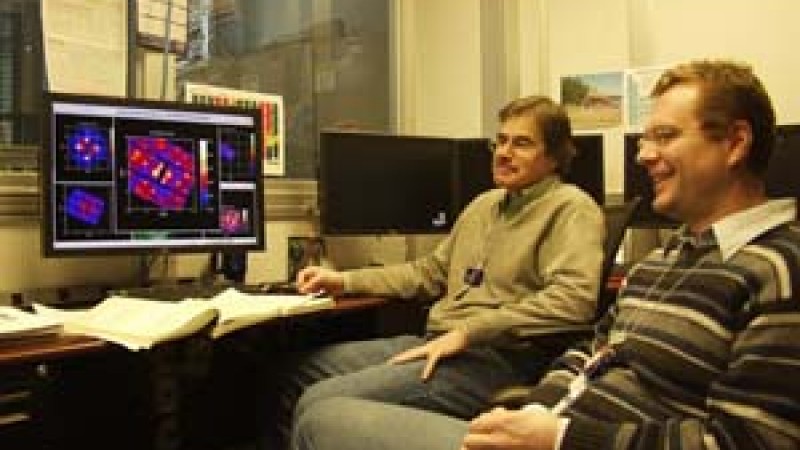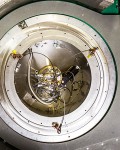The discovery of superconducting iron compounds in 2008 created a wave of excitement among materials scientists. The new materials offer the potential for big advances on two fronts: understanding the nature of superconductivity, and advancing efforts to tailor superconductors that lose their resistance to electrical current at higher, more easily attainable temperatures.
No iron-based material devised so far transitions to a superconducting phase at as high a temperature as the copper oxides, or cuprates, but their superconductivity has proved to be more robust and amenable to tinkering than in the finicky cuprates. And they present a world of experimental possibilities—researchers can create hundreds of superconducting permutations of iron-based parent compounds by doping them with increments of other elements.
John Tranquada and Igor Zaliznyak, both of Brookhaven National Laboratory, are using ARCS (the Wide Angular-Range Chopper Spectrometer ) at SNS to examine a sample of iron telluride, an iron compound that becomes superconducting when doped with selenium. Materials scientists understand very little about the magnetic correlations in these materials, and this effort is aimed at helping fill in the gaps.
Tranquada: We’re trying to get one little piece of the puzzle-when the material isn’t superconducting, what is the nature of these magnetic correlations. Can we understand it in a simple way? Can we tie it to some known model or can it be calculated from a commonly accepted starting point.
Aside from superconductivity, there’s the issue of understanding the magnetic properties of electrical conductors. We’re looking at the properties of the mobile electrons and how they can support both good conductivity and magnetic response. The magnets that are well understood are the ones in which the electrons can’t move.
Zaliznyak: And the conductors that are well understood are the ones in which the electrons don’t have a magnetic response, like copper or aluminum.
T: We understand those extremes. What we don’t understand is the combination of those features [mobile electrons plus magnetic response]. That’s where interesting things happen.
Z: The magnetic excitations in the iron tellurides are unusually energetic, with energies that extend up to hundreds of millivolts. Epithermal chopper spectrometers like ARCS and SEQUOIA (also at SNS) are the machines adapted for measuring magnetic dynamics at these energies. The only way to select neutrons at that energy to use is to let choppers select them. Spallation sources are essential for these studies because at a reactor, there are not many neutrons with that energy. So a spallation source and chopper spectrometers at the spallation source are a real breakthrough in this field—they’re what makes it possible.
T: Even with a substantial crystal sample, it takes a day to obtain a good quality measurement that can be compared at different temperatures. We’ve got 7 days of beam time for this experiment, and we’re going to need all 7 days to do a good job on this problem.
Z: At a facility with a third of the neutron flux of the SNS, we would need a month. … The physics is very complicated in these materials. The experimental investigation of the physics is very difficult, and it is only now with the rise of spallation sources and construction of spectrometers like ARCS that we can access the physics at all. We are measuring something that was totally immeasurable in the past century.
Iron telluride undergoes structural phase transitions as its temperature drops toward absolute zero (0 K). At 60–70 K, it enters an antiferromagnetic phase, a type of magnetic order in which magnetic moments of neighboring electrons align themselves in opposite directions. In bulk, the material has no magnetic order, but the alignment occurs at microscopic scale. Neutron scattering can detect the magnetic ordering and the resulting dynamics in the sample.
T: We’re looking at what happens to the magnetic order when you hit it with a neutron and watch the spins ring. It’s like hitting a violin string with a ball and measuring the sound the string makes by measuring the energy change of the ball that hit it.
The neutron scattering patterns show how the electrons respond to the magnetic interaction as it develops in the sample. The data show how strongly the electrons are coupled together, the root of all the unusual behaviors of the iron-based conductors, including the superconductivity that emerges when the material is slightly doped. Tranquada compared the experiments to shaking a Slinky toy to see how freely it moves.
T: If it’s a new, stiff spring, it’ll vibrate faster. If it’s a weak spring, it’ll vibrate slowly. By measuring the vibration frequencies of the system, we can learn how stiff or soft the electron coupling is.
Z: The electrons prefer to exist in correlated states; that’s what the antiferromagnetism is about. We are studying what correlated states they prefer to exist in. Magnetism is a correlated state in which electrons have their magnetic moments lined up in a particular way.
T: The electronic changes are subtle. We have to see whether we can understand the magnetism in non-superconducting materials in relation to the electronic structure.
Z: These materials are not metals in the usual sense because they are not held together by metallic bonding as metals typically are. It’s not clear cut, but most likely they are conductors that are held together by covalent bonding rather than metallic bonding. That is a commonality between these materials and cuprates: we have established that in the cuprates, the bonding between oxygen and oxygen is highly covalent. It’s unusual for oxides to be so strongly covalent. When you think of oxides, you usually think of metals.
It’s becoming accepted that the cuprates are strongly correlated and the iron-based materials are not as strong correlated. Before, it was commonly accepted that strong electronic correlations were basic to high-temperature superconductivity in the cuprates. I’m not so sure it remains commonly accepted now, with the discovery of the iron-based superconductors.
T: Strong correlations are a significant part of the high-temperature superconductivity in the cuprates. There’s a separate question: Are the strong correlations essential to getting high-temperature superconductivity. The iron-based superconductors show that’s not the case, it’s not essential to have the same strong electronic correlations. I would say there’s a question of whether there’s only one way to get high-temperature superconductivity and we’ll find it by understanding out how the iron-based superconductors and cuprates are similar. Are there multiple ways to get HTSC? In some ways, that would be better because it would give us hope of finding more superconducting materials.
Z: Establishing commonalities between different causes of high-temperature superconductivity is important. The existence of magnetism in parent materials and in superconducting doped materials seems to be a common feature. I would go further and say that goes hand in hand with strong covalent bonding in both classes of materials. I’m not saying that is the reason for the superconductivity, but this is a common feature.
T: With the problems we’re looking at, there are no fully accepted theories, so experiment can lead theory. We can put results out there that we can challenge the theorists to explain, which is fun. It’s more fun than trying to confirm someone else’s theory.





